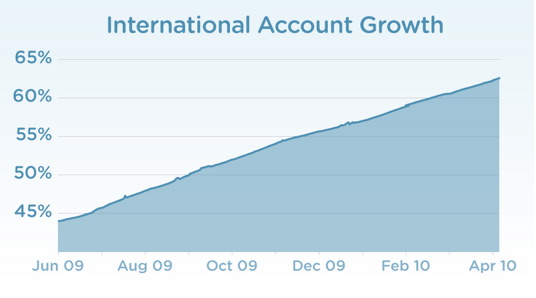Over the past six months, Twitter went from mostly serving people based inside the US to mostly serving people based outside of the US.

Today, 60% of Twitter’s 105 million registered users are based outside of the United States.
And half of all tweets are in a language other than English.
This is a remarkable trend, particularly since Twitter has only been localized into five languages so far.
A few months ago, I set out to better understand how large, multinational companies are using Twitter to reach users around the world.
I studied more than 225 companies across 21 industry verticals (representing 80% of the Interbrand 100). And I interviewed a number of people who manage Twitter feeds in different markets.
This work resulted in the report Twittering in Tongues. This report is a first stab at a phenomenon that is very much in its early days, so it’s hard to draw any sweeping conclusions. But there are some clearly emerging trends, which I discuss. I also highlight a number of Twitter’s inherent international limitations and provide some recommendations for companies considering localized Twitter feeds.
Here are a few findings/recommendations from the report:
- Most companies have yet to launch international Twitter feeds. Only one-third of the 225 companies studied support one or more Twitter feeds outside of their domestic markets. What makes this ratio interesting is that every one of 225 companies studied supports two or more localized web sites. So these are all companies that do business in three or more countries. A number of companies that support more than 20 local web sites still only use Twitter for their domestic markets.
- Sony leads the pack with support for 20 international Twitter feeds, mostly through its Sony Music division. Microsoft, Cisco Systems, and PricewaterhouseCoopers are also out in front with support for 10 or more country specific Twitter feeds. CAVEAT: Counting feeds is a tricky business. Not all corporate feeds are actively managed (which I did not count) and not all local feeds are easy to find.
- Brazil rules. Brazil is by far the most popular Twitter market outside of the US. Nearly half of the companies that support one or more international feeds have targeted Brazil. Not surprisingly, Brazilian Portuguese is the second most popular language used on Twitter.
- Local Twitter success depends on local web site promotion. It’s also no surprise that the local feeds with some of the highest numbers of followers also had high visibility on their local web sites. Companies such as Dell and Samsung lead in this respect. Below is a screen shot from Samsung’s Brazil home page; Twitter gets prime real estate.
- Twitter is local by design. Based on my interviews, most of the in-country Twitter feeds have been launched without any central approval process or even awareness. This also applies to local Facebook and YouTube pages. The evolution is local Twitter feeds is similar to the evolution of local web sites in the 1990s. Back then, local offices often created their own sites, with their own designs and platforms. Over the years, the central offices reined in these disparate sites — sometimes going too far and dampening local enthusiasm. The key challenge I see executies facing now is balancing local control with global consistency. While consistency is important, it should not come at the expense of local enthusiasm and innovation. In the end, the success of local Twitter feeds depends on the local offices.

For more information:
- Report: Twittering in Tongues
- Twitter blog post on global growth

Comments are closed.